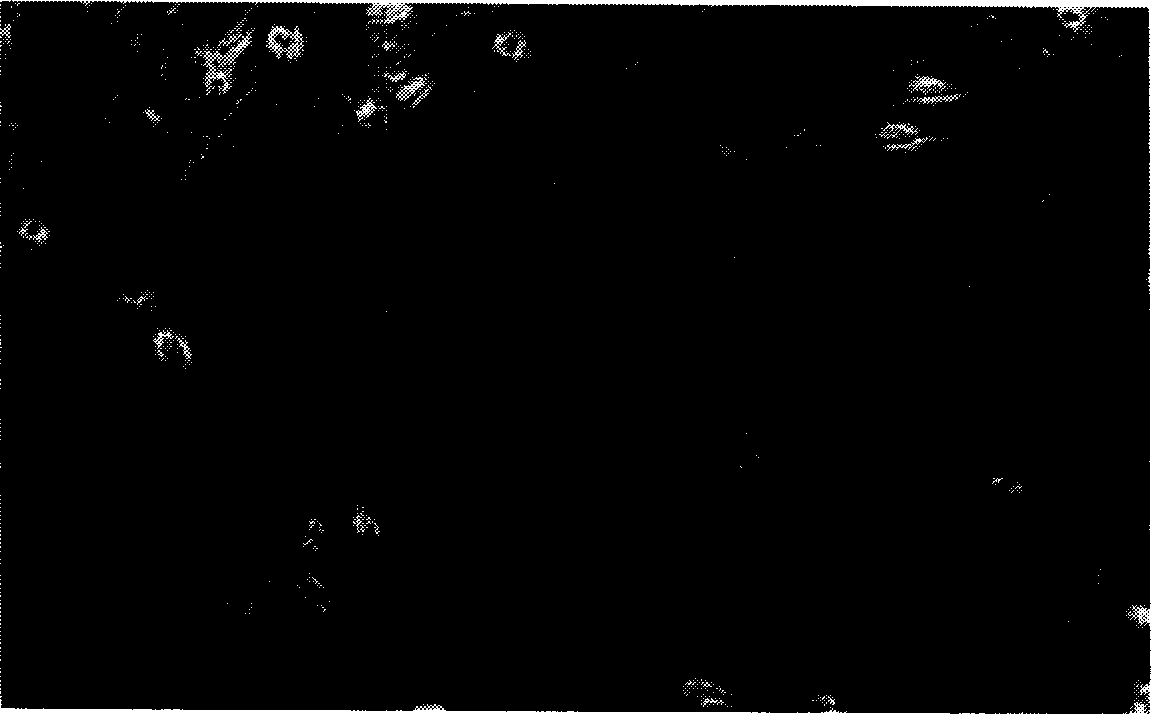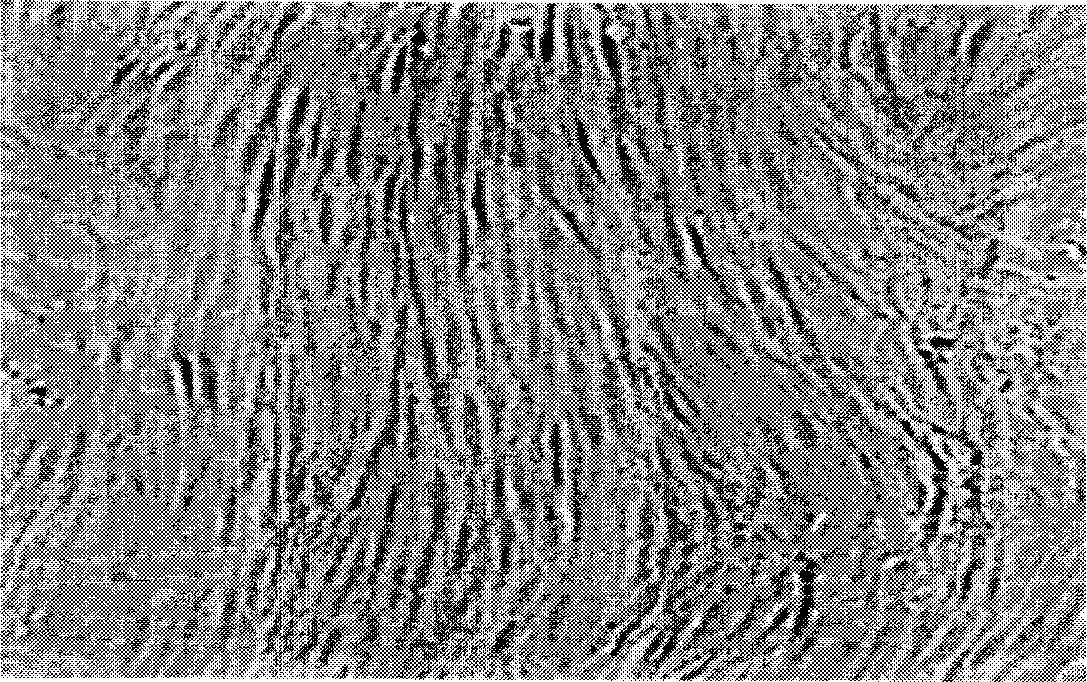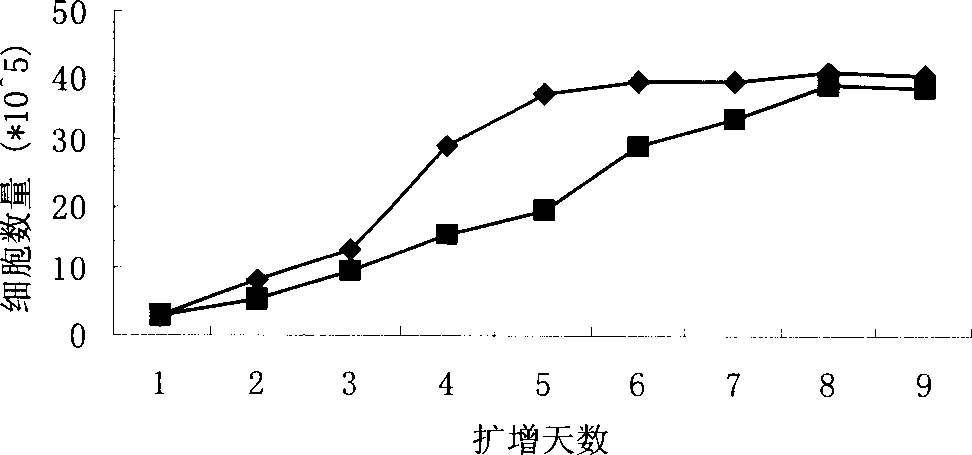Method for separating and in vitro culturing stem cells
A technology of bone marrow mesenchymal stem cells and culture methods, which is applied in the new biological field of bone marrow mesenchymal stem cell isolation and in vitro expansion and culture, can solve problems such as difficulties and poor sorting effects, and improve the expansion efficiency and improve the expansion efficiency. The effect of increasing capacity and improving purification rate
- Summary
- Abstract
- Description
- Claims
- Application Information
AI Technical Summary
Problems solved by technology
Method used
Image
Examples
Embodiment 1
[0030] A specific example taken by the method of the present invention is: after washing the bone marrow with an equal amount of calcium and magnesium-free PBS, suspending the cells with an equal amount of DMEM-LG culture fluid containing 10% FBS, and then slowly adding to a density of 1.073g / ml The mononuclear cell layer was collected by centrifugation on Percoll separation medium, washed 2-3 times with PBS, and washed with 5×10 6 / ml density inoculated in 10% FBS DMEM-LG medium for adherent culture.
[0031] 1. After the cells are layered in the culture flask, discard the culture medium and suspended cells. Adherent spindle cells were digested with Tryspin-EDTA and collected. Harvested cells were washed once with PBS and suspended in PBS. Then according to the instructions provided by MACS, CD14 was sorted from the suspension cells with the adsorption CD14 monoclonal antibody-magnetic bead separation system (MACS, Miltenyi Biotech Inc.) - Cells, and then use the adsorptio...
Embodiment 2
[0034] Separation and purification efficiency
[0035] Table 1 shows the proportions of different labeled cell surface antigens in cells at different stages of separation and purification determined by flow cytometry.
[0036] Table 1. Proportions (%) of different marker cell surface antigens in cells of different isolation and purification stages CD34 in isolation and purification stages + CD14 + CD105 + CD90 + Mononuclear cells 4.11 7.94 5.92 4.71 Primary adherent cells 0.35 8.19 54.51 42.63 CD14 - Cells 0.08 0.42 52.97 63.76 CD14 - CD105 + Cell 0.05 0.17 98.24 89.42
[0037] CD34 in primary isolated human bone marrow mononuclear cells + , CD14 + , CD105 + and CD90 + The average percentages of the cells were 4.11%, 7.94%, 5.29% and 4.71% respectively; after primary adherent culture into spindle cells, CD34+ Greatly reduced cells, CD105 + and CD90 + The proportion of cells increased, indicating that most of the primary adherent spindle cells were human bon...
Embodiment 3
[0039] Cell morphology at different culture stages
[0040] see figure 1 , 4 hours after primary cell inoculation, round cells with single nuclei can be seen attached to the wall, and cell colonies can be seen 2 days after inoculation. The formation of colonies can be seen. Each colony contains 20-50 cells, grows spindle-shaped, and is radial or concentric. Arranged in a circle. A large number of colonies appeared 4 days after inoculation and gradually layered on the bottom of the culture flask. It takes 14-16 days for cell expansion to form a monolayer in Teflen-75 flasks. But it can be seen from the figure that there are some suspended and adhered round cells. figure 1 Shown under an inverted microscope, the cells are spindle-shaped, 10×10 times.
[0041] see figure 2 , human bone marrow mesenchymal stem cells (CD34 - CD14 - CD105 + CD90 + ) under the culture system provided by the present invention (DMEM-LG: ginsenoside polysaccharide: 10% FBS) to carry out the fi...
PUM
 Login to View More
Login to View More Abstract
Description
Claims
Application Information
 Login to View More
Login to View More - R&D
- Intellectual Property
- Life Sciences
- Materials
- Tech Scout
- Unparalleled Data Quality
- Higher Quality Content
- 60% Fewer Hallucinations
Browse by: Latest US Patents, China's latest patents, Technical Efficacy Thesaurus, Application Domain, Technology Topic, Popular Technical Reports.
© 2025 PatSnap. All rights reserved.Legal|Privacy policy|Modern Slavery Act Transparency Statement|Sitemap|About US| Contact US: help@patsnap.com



